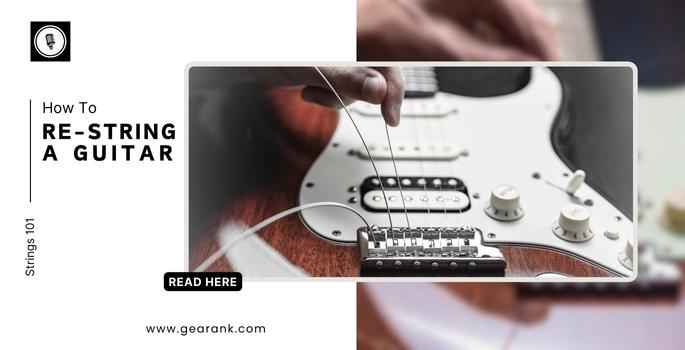How to Re-String a Guitar In No Time

Did a guitar string snap, or are your strings rusty and sounding dull? Even a brand-new guitar may come with old strings that need replacement.
Whichever the case may be, this article will teach you how to re-string a guitar yourself, covering these essential topics:
-
Steps On How To Re-String Guitar
-
Re-Stringing Acoustic Guitars
-
Tips For Restringing Your Guitar
This article mainly talks about changing strings on standard electric guitars. This won't cover special guitar types (like those with floating tremolo bridges), as they require specialized tools and processes.
With that out of the way, let's begin.
Steps On How To Re-String a Guitar
Step 1: Prepare Your Tools
These tools make the process of changing electric guitar strings faster and easier.
-
Workstation (or any clean table)
-
Guitar Neck Rest (or Some Books)
-
Guitar Tuner
-
Clean Cloth for Cleaning and Protecting Contact Points
-
Wire Cutters or Sidecut Pliers (Optional - For Easier String Manipulation and Cutting)
-
String Winder (Optional - For Faster Turning of the Tuning pegs)
-
Other Cleaning Tools (Optional)
Step 2: Ready Your Workstation
Prepare a table with a flat surface to lay your electric guitar on. Place a clean cloth (like a towel) or a rubber mat on top. This will help keep your instrument from getting scratched during the process.
Position your tools so you can easily reach them as you work on the table. Having them accessible will let you finish the process quickly.
Step 3: Level Your Guitar's Neck
Use a guitar neckrest to support your guitar's neck. You can use alternatives like a stack of books, best to top it off with a clean cloth to prevent unwanted scratches.
This will help avoid placing undue stress on your guitar's neck. It also ensures your guitar is balanced and secure on the table to avoid accidental sliding or movements.
Step 4: Remove All The Strings
Using a string winder, turn each tuning peg to loosen the strings. Then, using a pair of wire cutters or sidecut pliers, cut the guitar strings midway. This makes it easy to detach the old strings from the bridge and the tuning pegs.
Remember to be gentle when detaching the strings, and prevent any of its sharp edges from scratching your guitar's finish.
First, decouple the string from the tuner post. After that, remove the part attached to the guitar bridge.
Note: In the absence of wire cutters or sidecut pliers, simply pull out the strings from the tuning posts and bridge.
String winders make winding the strings faster and easier. But if you don't have one, just manually turn the tuning pegs.
Step 5: Install The New Strings
A guitar string has a ball end and a flat end. To install your new strings, insert the flat end of the string through the hole in the bridge.
Pull the string tight until its ball end is resting inside the bridge hole. Then, insert the flat end of the string through the hole of the tuning post.
Pull the string through the tuning post and leave an excess of 1.5" to 2.0". This excess will later turn into windings as you secure your strings in the post.
Note: Electric guitars have a variety of bridges that have unique functions. Some bridges require additional tools for inserting strings.
A floating tremolo bridge, for example, is fitted with the flat end of the string instead of the ball end. And you'll need an allen wrench for the locking nut and for balancing spring tension.
Step 6: Wind The Guitar Strings
Once you've moved it to your desired position in the tuning post, hold the string tightly with your fingertip. Bend that excess string end upwards to get it out of the way of your winding.
After that, using a string winder, turn the tuning key until the string is tight enough to produce a pitch or note. Notice the windings in your tuning post. Make sure that the windings are going down instead of up.
You want it short enough to be neat but long enough that it will give stability to your strings. 2–4 windings on the thicker strings (bass strings) and 4-6 on the thinner strings are good enough for this.
Note: During this step, it's also best to check the saddle and nut slots. Make sure that the string is in the correct slot position before tightening it into place.
Step 7: Tune Your Guitar
After all the strings are set and stretched, it's time to tune them. Start winding from the thickest string down to the thinnest string.
Standard tuning requires you to tune the open strings to E, A, D, G, B, and e (arranged from the thickest (wound strings) to the thinnest string). Use a tuner to ensure that each string is tuned accurately.
After tuning, give the strings a good pull to allow them to stretch and settle better. You'll notice that your guitar will start to go out of tune. Tune it back, then start playing again.
You'll notice that your strings will be more stable this time around and will go out of tune much later.
For best results, tune your guitar in the playing position, as there will be minute changes to the tuning compared to when the guitar is lying on a table.
Note: Newly installed strings will be unstable for a while because they're still stretching.
Re-Stringing Acoustic Guitars
The abovementioned steps are aimed mainly at electric guitars. However, the steps can also be applied to restringing an acoustic guitar, with just a few exceptions.
To restring an acoustic guitar, the main difference lies in the bridge. Electric guitars have metal bridges that are capable of bearing high string tension. On the other hand, acoustic guitars are hollow and are made of wood. And this requires a different type of bridge design, which utilizes bridge pins that secures the strings.
To install a new acoustic string on your acoustic guitar, you'll usually have to reach into the sound hole, to insert each string through the appropriate bridge hole. Then, insert the bridge pin into the hole, which will hold the string ball end in place.
Push down the bridge pins while pulling the strings to ensure they're in place. Once the strings snap into place, the bridge on your acoustic guitar is now set.
Removing the bridge pin is a bit tricky, and if you're not careful, you may scratch your bridge. You can use the bridge pin remover that's usually included in most string winders.
For a more detailed explanation, check out our article on "How to Restring an Acoustic Guitar."
Tips For Restringing Your Guitar
-
Clean Your Guitar: While the old strings are removed from your instrument, take this opportunity to clean your guitar.
With a clean cloth, wipe off the dirt from the guitar's fretboard and the guitar's body. If you have some basic maintenance kits, applying an instrument cleaner or conditioner would be better.
Also, after playing your guitar, wipe the strings to reduce the accumulation of dirt and sweat.
-
Tidy Up: Your newly installed strings will have some excess length hanging out. For safety, cut them using wirecutters, or you can wrap the excess strings into circles.
Some players like a messy look and deliberately don't cut their guitar strings, but the excess can cause damage to your guitar and your guitar case. And if you're not careful, you can get hurt. The excess wires may accidentally poke someone's skin, or worse, eyes.
-
Don't Rush: When re-stringing, avoid rushing as you may end up over-stretching your strings, which can result in string snapping. Keep an eye on the tuner as you tune. The same principle applies to selecting the type of string and string gauge to use. Different types of strings can impact playability and sound, for example nickel plated steel is known for their warm tonality. On the other hand, gauges impact playability. So consider your playing style and tone preferences when replacing your strings.
Final Thoughts
Knowing how to re-string a guitar is a must for anyone who owns and plays a guitar. A string that is in good condition will always sound better and play smoother.
As outlined in this article, the process is simple and doable, so you won't have to ask a friend or a tech to do it for you.
Some find the process difficult at first, but the more you change guitar strings, the more efficient and confident you will be at doing getting strings installed.
Now, on to responses to related FAQs.
Frequently Asked Questions
How Often Should I Change Strings?
It depends on how much you want to use the guitar. If you gig regularly and want your instrument to sound and feel fresh, then changing strings every month or even every 2 weeks is a good idea.
If your budget is limited and you're not playing professionally, then you can extend the use of your strings to months or longer, as long as the strings aren't rusty or deformed.
Once the strings are rusty or deformed, you will start encountering tuning and intonation issues that require string replacement to resolve.
Will Cleaning Extend the Life of My Guitar Strings?
Yes, especially when you have a good case and live in an area with good weather. Coated strings can last even longer, especially when the strings are well taken care of.
But regardless of how much you clean the strings, don't expect them to last forever. You will still need to change the strings in the future.
Our fingertips produce sweat, which is corrosive to guitar strings, so eventually, they all start to wear and will tend to sound duller as time passes.
Can I Leave My Guitar Without Strings For a Long Time?
Doing this may cause your guitar's neck to bow or warp. A guitar's neck has a truss rod, which balances the tension by serving as a counterforce to the strings.
Removing that opposing force (the strings) will leave the truss rod pushing in one direction without any resistance.
Contributors:
- Jerome Arcon - Co-writer
- Jerry Borillo - Illustrator












